|
Goldfish Diary
2004/1
Goldfish Appreciation Series - The Pearlscales
In this issue we showcase the beautiful pearlscale varieties and
the very rare black dragon eye pearl bred by our club.
|
|
Legend
has it that during the Qing dynasty, an entourage from India
brought the first pearlscale variety as a tribute to the
Empress Dowager Ci-Xi. Accordingly, the pearlscale variety was
the outcome of genetic mutation of the wen-yu (fantail) in India
that originated from China centuries ago.
Decades of selective breeding has resulted in many sub-varieties
of the pearlscale. The oldest line is perhaps the classical
pearlscale from northern China. This beautiful variety has a small pointed head
contrasting with a big belly, pronounced pearls, a graceful tail
with a very shallow indent, looking very much like a veil tail.
Unfortunately, for commercial reasons, it has not been bred
extensively and is rather rare out of China. |
|
|
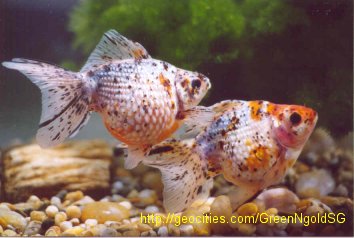 |
|
The calico classical pearl - an ancient line of pearlscale |
|
|
|
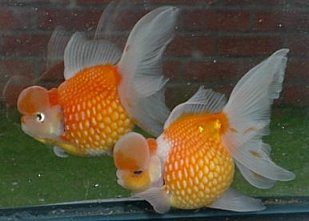
A pair of red-white crown pearl |
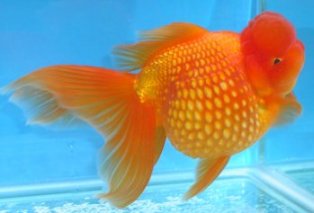
An all red crown pearl - 2003 Aquarama Pearl
class champion |
|
|
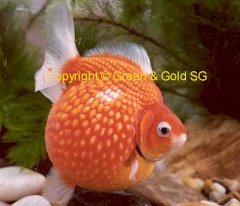
The famous Malayan short tail
pearlscale |
| The
most commonly seen sub varieties in Asia is the Malayan
short tail pearl - the pride of the Ipoh goldfish farmers
from Malaysia. Locals like to refer them as the "go-li"
(marble ball), golf-ball, ping-pong ball or the "tikus"
("mouse" in Malay dialect) pearlscale. This very unique
variety breeds true with a very small head, rounded body and
a short tail. Although they seldom grow to a big size, they
are cute little fellows that look like clumsy variegated
balls. |
| |
The crown pearlscale (the
Japanese called them the Hamanishiki) is perhaps the most famous of the pearl
variety. Created by crossing the pearlscale with the oranda and
debut in the 80s, this variety exhibits a majestic rounded body
with either a single or double crown. It can attain a size of
more than 11 inches in an optimal environment.
|
| |
|
|
|
As
with many other varieties of goldfish, the ingenious Chinese
breeders has produced different color variations of the pearlscale - blue, brown, green, red,
red-white, white, black, red-black, calico, etc. One of the rarest sub variety of
the crown pearl is the dragon eye crown pearl - the seamless
union of the grace of the crown pearl with the beautiful
oriental features of the dragon eye! . Yet another very new
variation of the crown pearl is one with pompons on its
nostrils!
|
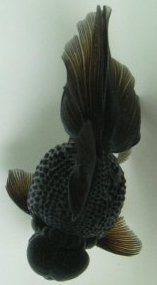 |
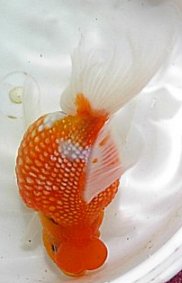 |
|
The pearl
variety also looks beautiful from the top view |
|
|
|
|
 |
|
Very rare
brown crown pearl from Tung Hoi
Aquarium Company |
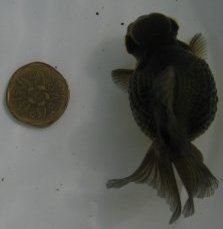 |
|
A baby
dragoneye pearl |
|
|
|
Our
club has been quite successful in breeding the rare black dragon
eye pearl, the cream of the crop of 200 out of nearly 3000
fries. Even then, not all the siblings have dragon eye features,
most of which are normal eye black pearls. Nevertheless, the
line is unique with good body shape and finnage. As black is an
unstable colour in goldfish, some will shed to red, red-black or
remains green in colour as they mature. A true black pearl
is rare, let alone the black dragon eye pearl. Hopefully, there
will be some fries that retains the jet black colour like their
parents.
Keeping wise, the pearl variety
is more demanding in space and water quality than most other
varieties of goldfish. Their sensitive scales tend to show
streaks of red or inflammation if the water is not well taken
care of. So as long as hobbyists maintain good water parameters
and avoid overcrowding, they will have success in keeping this
very beautiful variety.
We welcome you to send your
comments to GreenNgoldSG@yahoo.com
or sign on our
Guest Book.
To see other
articles in our goldfish diary, let's go back to our
diary home page.
28 March 2004 |
 |
 |
Baby black normal
eye and
dragoneye crown pearls bred
by the Vermillion Goldfish Club |
|
| |
|
|
|
|